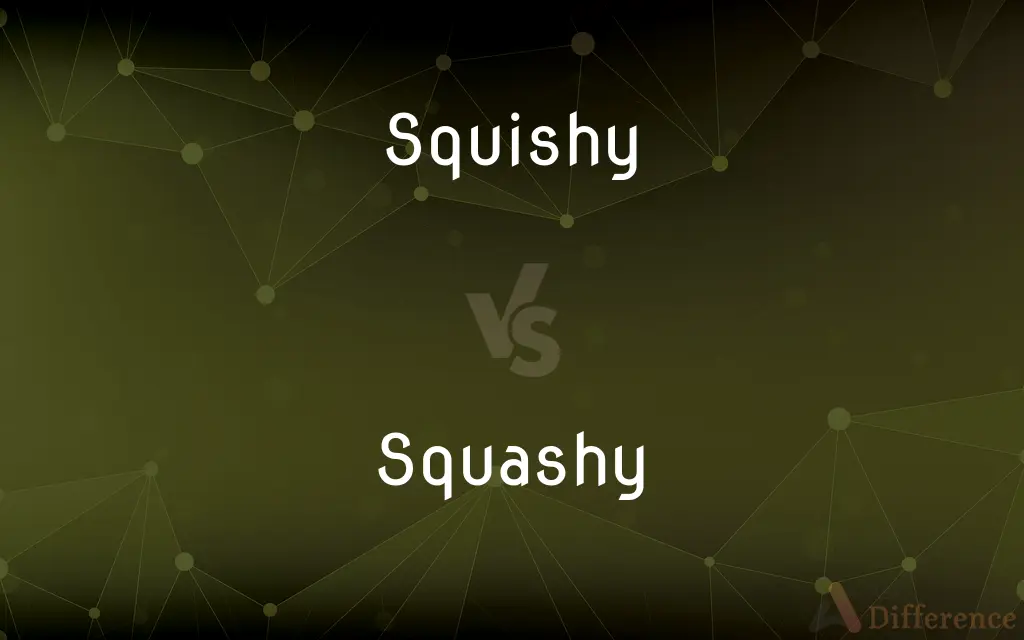Squishy vs. Squashy — What's the Difference?
By Tayyaba Rehman & Urooj Arif — Updated on April 5, 2024
Squishy objects are easily compressed and often bounce back, ideal for stress balls, while squashy items are softer, possibly overripe, and less resilient, like overripe fruit.

Difference Between Squishy and Squashy
Table of Contents
ADVERTISEMENT
Key Differences
Squishy objects, characterized by their softness and elasticity, return to their original shape after being compressed. This quality makes them popular for toys and stress-relief items. On the other hand, squashy items are also soft but tend to deform or break apart when pressure is applied. This term often describes food textures, indicating a lack of firmness that might not recover its shape, suggesting a state of overripeness or decay.
Squishy materials are often made from synthetic compounds designed to provide a satisfying tactile experience. These materials can endure repeated compression and expansion, making them durable over time. Whereas squashy materials might be natural and not designed for durability. Their softness often results from natural processes, such as ripening, which makes them less ideal for applications requiring long-term resilience.
The appeal of squishy items lies in their ability to provide sensory feedback and stress relief through the act of squeezing. This interaction is both physical and psychological, aiding in concentration and emotional regulation. On the other hand, squashy items are generally not sought for tactile interaction but are encountered in contexts like cooking or eating, where their texture is an indicator of quality or readiness for consumption.
In terms of usage, squishy is often used in a more playful, light-hearted context, reflecting its association with toys and leisure activities. It conveys a sense of fun and engagement. In contrast, squashy is more frequently used in everyday, practical contexts, particularly in relation to food and organic materials, where it might indicate a less desirable state.
While both squishy and squashy describe softness and a degree of malleability, the contexts in which they are used and the specific characteristics they denote vary significantly. Squishy emphasizes resilience and fun, whereas squashy points to softness without the promise of return to form, often with an implication of over-maturity or decay in foods.
ADVERTISEMENT
Comparison Chart
Material
Often synthetic, designed for resilience
Natural, prone to breaking apart or crushing
Resilience
High, returns to original shape
Low, may not regain original form
Typical Use
Toys, stress relievers
Describing food texture or overripeness
Connotation
Playful, stress relief
Often negative, indicating overripeness
Tactile Feedback
Designed for sensory satisfaction
Indicative of quality or state (in foods)
Compare with Definitions
Squishy
Easily compressed but quick to return to original shape.
The squishy toy amused the child for hours.
Squashy
Easily crushed or mashed.
The squashy tomatoes were too ripe for the salad.
Squishy
Soft and satisfying to squeeze.
She preferred the squishy cushion for its comfort.
Squashy
Indicating overripeness in fruits or vegetables.
The squashy banana was used for baking instead.
Squishy
Playful and stress-relieving texture.
The squishy stress ball was a hit in the office.
Squashy
Soft and lacking firmness.
He avoided walking on the squashy ground after the rain.
Squishy
Indicating a quality of being pleasantly soft.
The squishy marshmallows were perfect for s'mores.
Squashy
Not resilient or durable under pressure.
The squashy loaf of bread deflated when touched.
Squishy
Resilient and elastic material.
The squishy gel pads helped alleviate foot pain.
Squashy
Often associated with a negative connotation of decay.
The squashy pumpkin had to be thrown away.
Squishy
Soft; spongy.
Squashy
Easily squashed.
Squishy
Making a squishing sound.
Squashy
Overripe and soft; pulpy.
Squishy
Not clearly definable; inexact
A squishy category.
Squashy
Boggy; marshy
Squashy ground.
Squishy
Sentimental; mawkish
Squishy feelings.
Squashy
Easily squashed when pressed.
A squashy tomato
Squishy
(of an object or substance) Yielding easily to pressure; very soft; especially, soft and wet, as mud.
Squashy
Resembling a bog or marsh underfoot.
Squishy
(slang) Used as a term of endearment. en
Squashy
Easily squashed; soft.
Squishy
(informal) Subjective or vague.
Squashy
Resembling a sponge in having soft porous texture and compressibility;
Spongy bread
Squishy
Politically moderate.
Squishy
(informal) A squeezable foam toy.
Squishy
Resembling a sponge in having soft porous texture and compressibility;
Spongy bread
Common Curiosities
What makes an object squishy?
An object is squishy if it's soft, compressible, and returns to its original shape after being squeezed.
Why are some fruits squashy?
Fruits become squashy when overripe or decaying, losing their firmness and becoming easily crushable.
Can food be squishy?
Yes, some foods can be squishy if they are soft and moist, like marshmallows, but the term is more commonly applied to non-edible items.
What's the difference between squishy and soft?
Squishy implies a level of compressibility and resilience not inherent in all soft objects.
Are squishy toys safe for all ages?
Most squishy toys are safe for various ages, but it's important to check for non-toxic materials and age recommendations.
Can squishy materials be recycled?
Recycling squishy materials depends on their composition. Synthetic squishy items may not be recyclable, whereas natural squashy materials are biodegradable.
Do squishy items lose their shape over time?
High-quality squishy items are designed to maintain their shape through many compressions.
Is a squashy texture always undesirable?
In the context of food, squashy often indicates overripeness or spoilage, but it might be preferred for certain recipes, like banana bread.
Are squashy vegetables bad?
Squashy vegetables may be overripe or spoiled, potentially unsuitable for raw consumption but could be cooked or baked.
How do I clean squishy toys?
Cleaning methods vary, but gently wiping with a damp cloth and mild soap is effective for most squishy toys.
Can squashy indicate ripeness in some fruits?
Yes, in fruits like peaches or avocados, a slightly squashy texture can indicate perfect ripeness for eating.
Can squashy be a positive description?
It's less common, but in some contexts, like ripe avocados for guacamole, squashy might be positively viewed.
Is there a scientific measure for squishiness?
While not commonly standardized, material science examines properties like compressibility and resilience that contribute to what is perceived as squishy.
What types of squishy items are most popular?
Stress balls, squishy toys, and comfort cushions are among the most popular squishy items.
How do you determine if a fruit is too squashy to eat?
If a fruit is excessively soft, emits a foul odor, or shows signs of mold, it's too squashy and should not be eaten.
Share Your Discovery

Previous Comparison
Brilliant vs. Wonderful
Next Comparison
Ice vs. AceAuthor Spotlight
Written by
Tayyaba RehmanTayyaba Rehman is a distinguished writer, currently serving as a primary contributor to askdifference.com. As a researcher in semantics and etymology, Tayyaba's passion for the complexity of languages and their distinctions has found a perfect home on the platform. Tayyaba delves into the intricacies of language, distinguishing between commonly confused words and phrases, thereby providing clarity for readers worldwide.
Co-written by
Urooj ArifUrooj is a skilled content writer at Ask Difference, known for her exceptional ability to simplify complex topics into engaging and informative content. With a passion for research and a flair for clear, concise writing, she consistently delivers articles that resonate with our diverse audience.














































